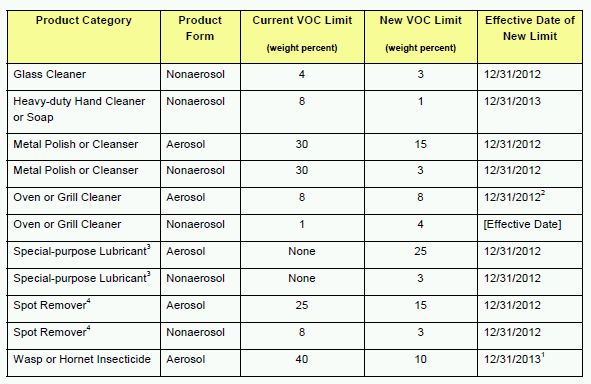California's air pollution rules for consumer products—always a trap for the unwary out-of-state business— just got tougher. On November 18, 2010, the California Air Resources Board ("CARB") adopted revisions to its Consumer Products Regulation for 11 categories of products, including general purpose cleaners and degreasers, glass cleaners, oven and grill cleaners, and insect sprays. Three categories of products, grill cleaners, special-purpose lubricants and spot removers used in industrial dry cleaning, are restricted for the first time. The regulations take effect on December 31, 2012 for some products, and on December 31, 2013 for others.
These new restrictions may come as a surprise to manufacturers, distributors and retailers, especially for those products regulated for the first time. The regulations are part of CARB's efforts over the last 20 years to restrict air emissions from consumer products. To date, the agency has set limits for volatile organic compounds ("VOC") for 127 consumer product categories. These new regulations are anticipated to reduce air emissions by seven tons per day. The adopted limits for all categories, when fully effective, are expected to reduce VOC emissions by about 225 tons per day, an overall 50 percent reduction as compared to 1990 levels.
NEW PRODUCT VOC LIMITS
The following table summarizes the changes made by the new regulations:


Notes to Table:
1. For products subject to Federal Insecticide, Fungicide and Rodenticide Act registration, the effective date is one year after the date in the standards table.
2. The definition of "Oven or Grill Cleaner" is modified to include grill cleaning products that were not previously regulated. For grill cleaning products included for the first time, VOC limits that are already applicable to oven cleaners will take effect December 31, 2012.
3. "Special-purpose lubricants" are cutting or tapping oils; anti-seize products; open gear, chain or wire lubricants; and products which claim to prevent and/or inhibit corrosion that make a lubricating claim; but not a lubricant that is otherwise regulated under the Consumer Products Regulation.
4. Spot Remover products used by the dry cleaning industry, previously exempt from the Spot Remover category, are regulated for the first time. In addition, the lowered limits for general Spot Removers were extended from December 31, 2010 to December 31, 2012 to keep a single date for all of the covered Spot Remover products.
ADDITIONAL RESTRICTIONS ON PRODUCT REFORMULATION
For these and other product categories, CARB also prohibits the use of certain VOC substitutes to reformulate the products because those substitutes may have other toxic effects. For the categories "Metal Polish or Cleanser," "Silicone-based Multi-purpose Lubricant," and "Special-purpose Lubricant" the regulations prohibit the substitution of methylene chloride, perchloroethylene, and trichloroethylene, which are toxic air contaminants.
For the categories "General Purpose Cleaner" (nonaerosol), "General Purpose Degreaser" (nonaerosol), "Glass Cleaner" (nonaerosol), "Heavy-duty Hand Cleaner or Soap" (nonaerosol), and "Oven or Grill Cleaner" products, the regulations prohibit the substitution of alkylphenol ethoxylate surfactants, because those surfactants can be toxic to aquatic species.
For the categories "Flying Bug Insecticide," "Furniture Maintenance Product," "Metal Polish or Cleanser," "Special-purpose Lubricant," "Spot Remover," and "Wasp or Hornet Insecticide" products, the regulations prohibit the substitution of high greenhouse gas chemicals.
PENALTIES AND INJUNCTIVE RELIEF
Violation of the VOC limitations can result in civil penalties of up to $50,000 per day for regulated products distributed, offered for sale or sold in California. CARB may also seek to prohibit further sales of non-compliant products.
CARB is aggressively enforcing the consumer product VOC regulations. For example, in March of this year, a distributor of consumer products paid over a million dollars in penalties and costs to settle allegations that some of the products it distributed to California retailers did not meet California's VOC limits. The state also prosecuted seven major retailers for having sold the products supplied by that distributor. One issue in the case was how products that meet the California requirements could be distinguished from the same products intended for distribution outside the state that do not meet the California limits. CARB generally does not require that the product label state whether it complies with the California rules, and has declined to impose such a requirement. Thus, for retailers and distributors the rules are truly a trap for the unwary.
CONCLUSION
With as little as a year to reformulate or remove products, manufacturers will need to quickly plan for replacement products to comply with CARB's new regulations. And because distributors and retailers can be penalized for selling non-compliant products, they also must be vigilant. Morrison & Foerster continues to monitor CARB's rulemaking in this area and is providing additional assistance to regulated parties as they attempt to meet CARB's deadlines for their products
Because of the generality of this update, the information provided herein may not be applicable in all situations and should not be acted upon without specific legal advice based on particular situations.
© Morrison & Foerster LLP. All rights reserved
